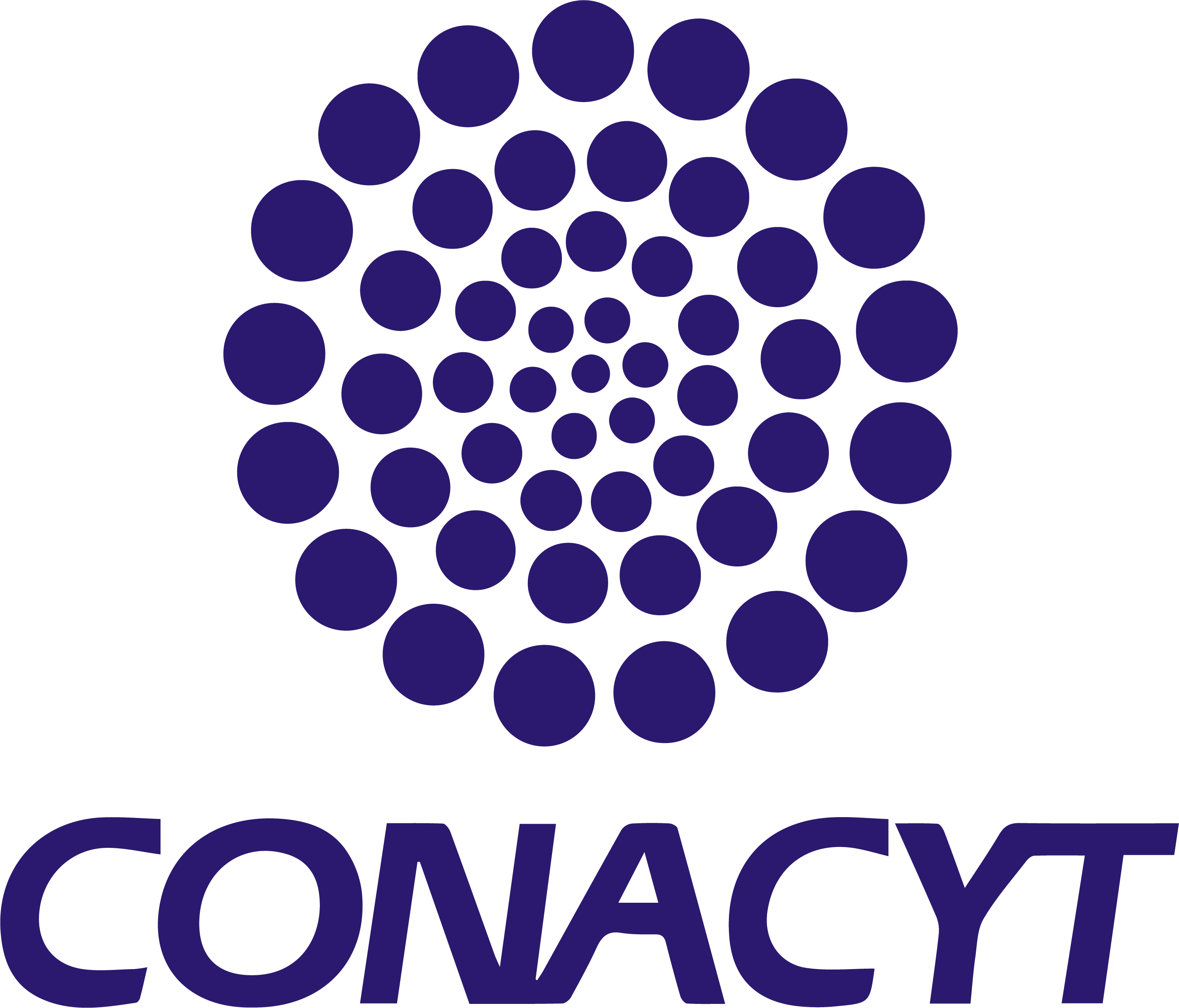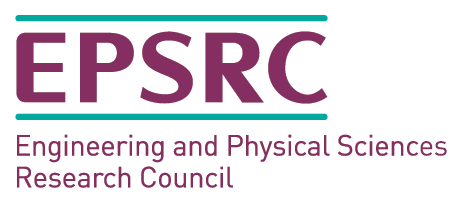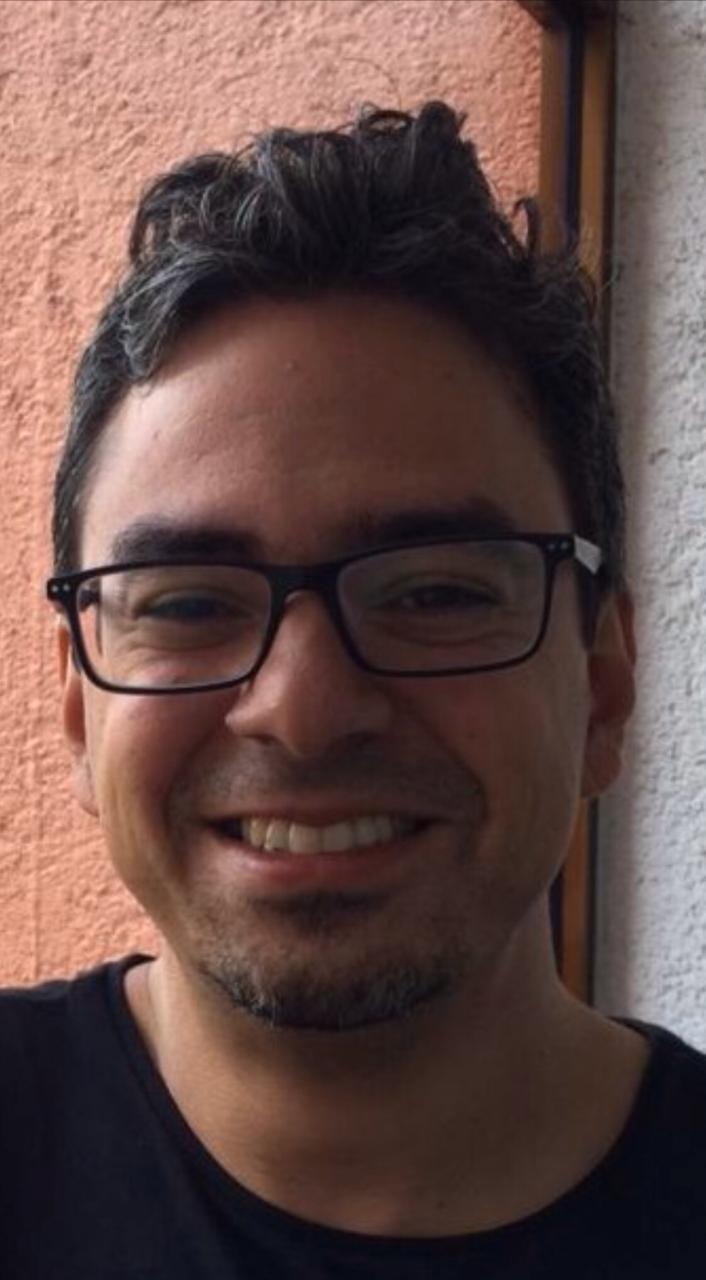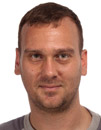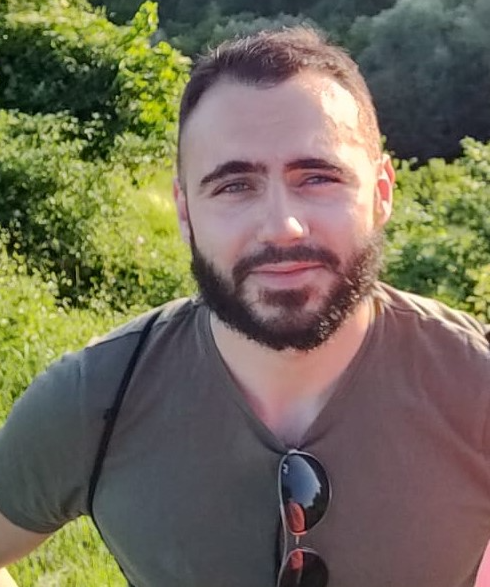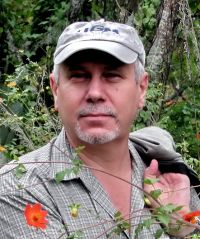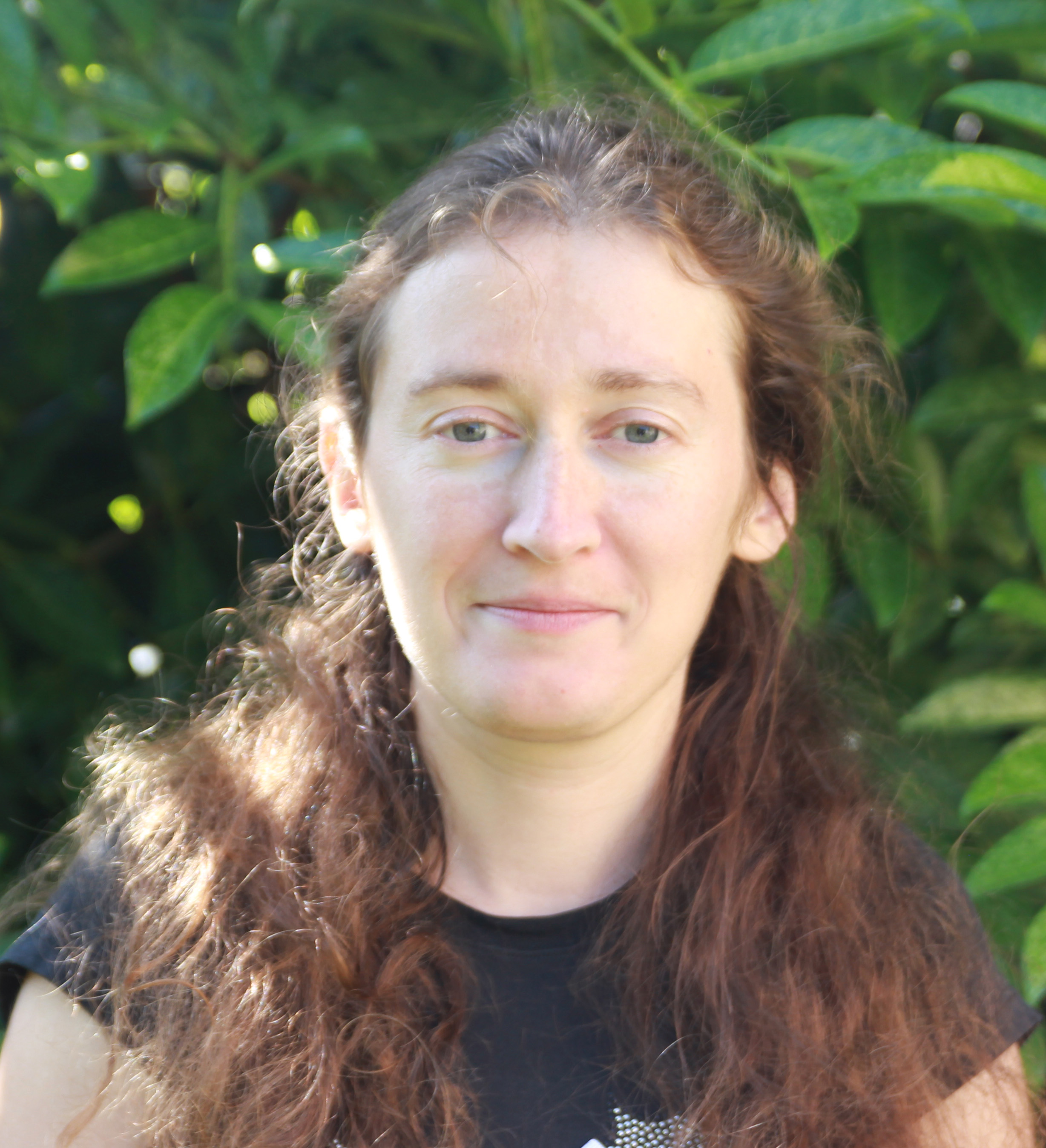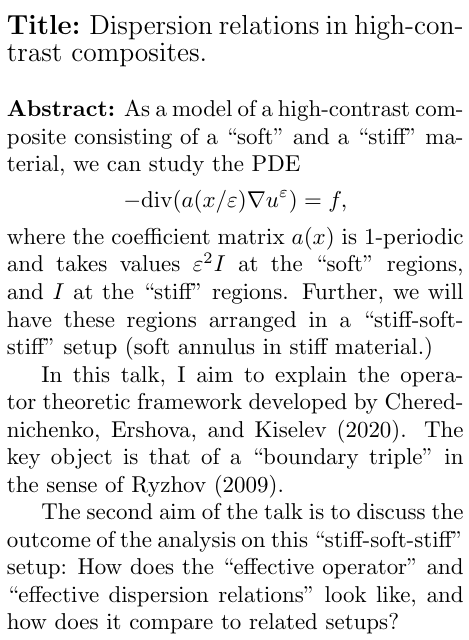Threshold phenomena in spectral analysis and their applications to waves and tectonics (Summer School and Workshop)
Overview
The events are part of a series of mathematical research activities organized by the Department of Mathematical Sciences at the University of Bath and Mexican mathematicians based in UNAM and CIMAT (BUC). The present instalment (UMAR-BUC) is a collaboration with a partner institution, Universidad del Mar.
The School (held at Universidad del Mar on 12-15 July 2022)

The school will introduce the participants to modern methods of mathematical analysis for the study of classical and quantum physical systems. There will be four mini-courses on topics of mathematical physics and materials science.
The Summer School will be held at Instituto de Investigación de Matemáticas y Actuaría, Universidad del Mar (Campus Huatulco).
The Workshop (held at IIMAS (Universidad Nacional Autónoma de México) on 19-22 July 2022)
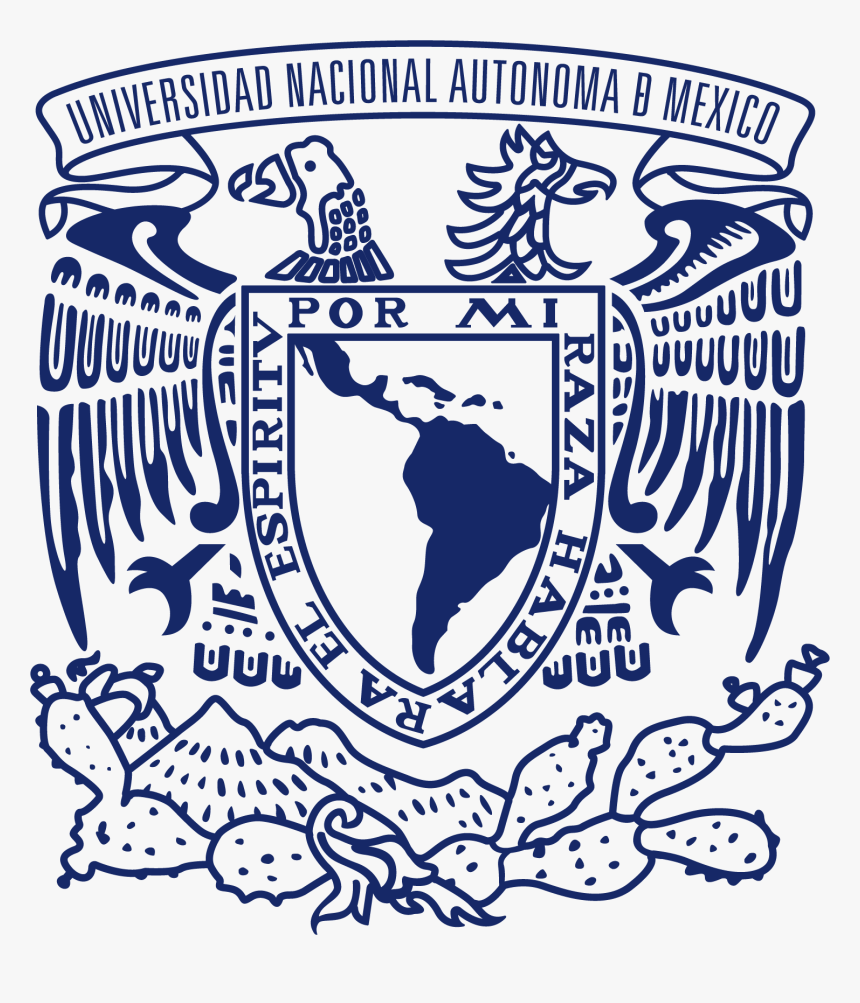
The workshop will combine two kinds of activity: research talks in the morning and collaboration sessions in the afternoon. The morning talks will be given by analysts from Bath, IIMAS–UNAM, and partner institutions, who will highlight the current research in the areas of differential equations, operator theory, and their applications to mathematical physics, materials science, wave propagation in continuum mechanics and electromagnetism. The material of the talks will be used as a basis for making an advance on the interfaces between the subjects touched upon.
Further Details (School)
|
Course
|
Title and Abstract
|
|
Kirill Cherednichenko (University of Bath)
A
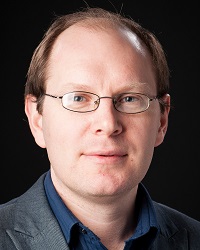 Video recordings:
|
Title: Multiscale analysis as an evolving subject: from effective constants to effective dispersions
Abstract: This mini-course is an introduction to "effective" descriptions of the behaviour of highly inhomogeneous media. It will start with an overview of what can now be referred to as "classical homogenisation", i.e. a range of mathematical techniques aimed at providing a set of material constants that (in some rigorous sense) represent the response of the medium to long waves or loads varying at length scales that are much larger than the size of the heterogeneity. Through examples, we will then see how the limitations of such techniques emerge, how they can be overcome, and what kind of "generalised" effective descriptions one arrives at upon relaxing the assumptions of classical homogenisation. Finally, I will address some links of the new approaches to the design of novel materials with "unusual" properties.
|
|
Danila Prikazchikov
(Keele University)
B
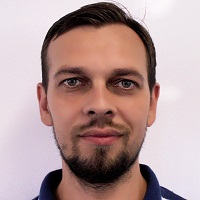 Video recordings:
|
Title: Low-frequency vibrations of strongly inhomogeneous elastic structures
Abstract: The consideration is focused around the lowest spectra in problems of vibrations of elastic structures comprised of "stiff" and "soft" components, including multi-span rods, beams, scalar problems of anti-plane elasticity, and multi-layered plates. In case of 1D problems the leading order frequency equation is derived in polynomial form. At leading order, the stiff components perform rigid body motions, with the soft ones undergoing homogeneous deformations. Consideration of strongly inhomogeneous plates leads to multimode expansions of the exact dispersion relation in the low-frequency long-wave region, with the approximations being either uniform or non-uniform depending on the material setup.
|
|
Stephen Shipman
(Louisiana State University)
C
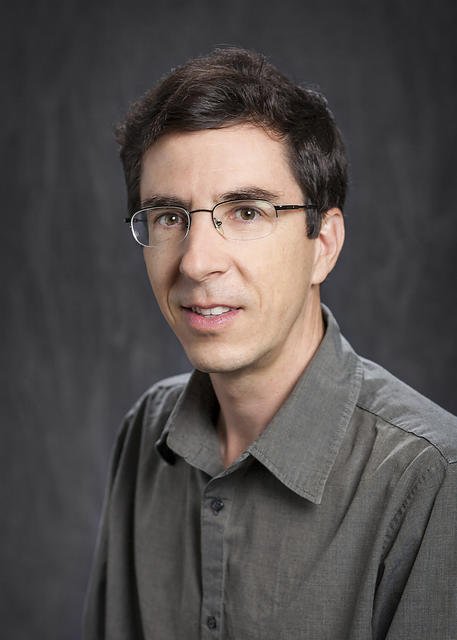 Video recordings:
|
Title: The Bloch and Fermi varieties for periodic operators, and open problems
Abstract: A classical or quantum dynamical system in a periodic medium is associated with a Fermi surface, which is the set of all quasi-momenta admitted by the system at a given energy. This is an analytic or algebraic variety, as is the associated Bloch variety, and its properties such as reducibility, extreme values, and singularities, determine characteristics of the spectral theory and dynamics of the system. The construction and meaning of these varieties is based on discrete Fourier analysis and the resulting direct-integral spectral resolution of the relevant periodic operator. The course will develop the theory, review some key results, and discuss applications and open problems.
|
|
Euan Spence
(University of Bath)
D
 Video recordings:
|
Title: Numerical analysis of the high-frequency Helmholtz equation -- a case study in applied analysis
Abstract: The goal of this mini-course is to illustrate how tools from analysis can be used to answer important questions in the numerical analysis of the Helmholtz equation. We will focus on the question "when the finite-element method is applied to the high-frequency Helmholtz equation, how must the number of degrees of freedom grow as a function of frequency?" This is a classic question that has enjoyed sustained interest from the numerical-analysis community since the 1990s, and remains an active area of research today. We will show how, in the simplest-possible case of the constant-coefficient Helmholtz equation posed in
|
-->
| Tuesday 12 July |
|
|
|
Breakfast
|
|
15:00-15:30
|
Introduction
|
|
15:30-16:30
|
Leonardo Lopes Abath (Universidad del Mar) Title: Capacitive networks Abstract: In this talk, we will treat circuits where their branches have at most a battery in series with a capacitor. When the battery is triggered, charges will accumulate on the plates of the capacitor until eventually a steady state is reached. In this state, no current will be owing. At this time, we are interested in discovering the charge on nodes and capacitors, and the voltage on the branches. To achieve this goal, we will study the resolution of the Poisson equation and the Dirichlet problem, ending with the study of Green's functions. The importance of studying capacitive circuits lies in the fact that the study of these circuits is equivalent to the study of a discretization of electrostatics. |
|
16:30-17:30
|
Andrew Comech (Texas A&M University) Title: Virtual levels of linear operators in Banach spaces Abstract: We review the theory of virtual levels in a general setting of linear operators in Banach spaces. We recall that a point of the essential spectrum is a virtual level if the resolvent does not have a limit at this point as an operator in certain regularizing spaces; alternatively, an arbitrarily small perturbation can produce a bifurcation of an eigenvalue from this point. We construct examples in the case of shift operators and in the case of Schrodinger operators. This is joint work with Nabile Boussaid (University of Franche-Comte, Besancon). |
|
17:30-18:00
|
Discussion
|
| Wednesday 13 July |
|
|
8:30-9:30
|
Breakfast
|
|
9:30-10:30
|
A
|
|
10:30-11:30
|
D
|
|
11:30-12:00
|
Coffee
|
|
12:00-13:00
|
C
|
|
13:00-14:30
|
Lunch
|
|
14:30-15:30
|
B
|
|
15:30-16:30
|
Julius Kaplunov (Keele University) Title: Dynamics of a thin elastic layer lying on a Winkler foundation. Abstract: A mixed 3D dynamic problem for a thin layer supported by a softer foundation is considered. First, the conventional asymptotic scaling corresponding to plate bending is explored. Leading and next order approximations are derived [1]. Comparisons with 2D engineering formulations, including a Kirchhoff plate resting on a Winkler foundation, are presented. Then, the degeneration of the above-mentioned scaling near the cut-off frequency is discussed. A specialised near cut-off expansion is constructed. The relation issue of the veering of extension and bending waves, due to asymmetry of the problem, is addressed [2]. This is joint or with B. Erbaç. References: [1] Erbaç, B., Kaplunov, J. and Elishakoff, I., 2021. Asymptotic derivation of a refined equation for an elastic beam resting on a Winkler foundation. Mathematics and Mechanics of Solids, doi:10.1177/10812865211023885. [2] Erbaç, B., Kaplunov, J., Nobili, A. and Kılıç, G., 2018. Dispersion of elastic waves in a layer interacting with a Winkler foundation. The Journal of the Acoustical Society of America, 144(5), pp.2918-2925. |
|
16:30-17:30
|
Discussion
|
| Thursday 14 July |
|
|
8:30-9:30
|
Breakfast
|
|
9:30-10:30
|
C
|
|
10:30-11:30
|
D
|
|
11:30-12:00
|
Coffee
|
|
12:00-13:00
|
B
|
|
13:00-14:30
|
Lunch
|
|
14:30-15:30
|
A
|
|
15:30-16:30
|
Alexander Kiselev (IIMAS-UNAM)
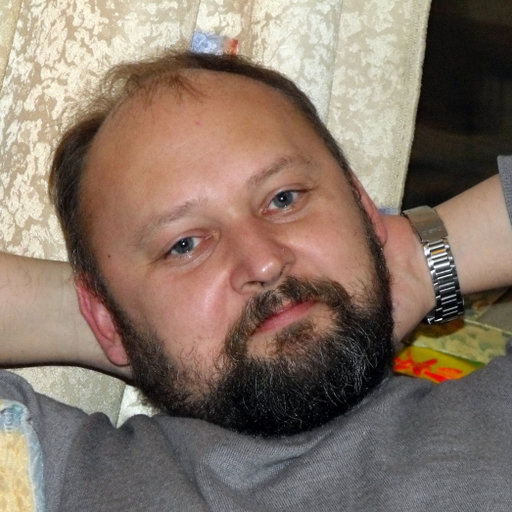 Title: Generalised resolvents and out-of-space extensions of symmetric operators
Abstract: I will cover the subject area of generalized resolvents, which have recently appeared prominently in the asymptotic analysis of inhomogeneous media. I will aim to give a reasonably complete introduction to this subject, covering the seminal contributions of Neumark and Strauss as well as the concrete applications of this general framework in the modern materials science and applied mathematics. |
|
16:30-17:30
|
Discussion
|
| Friday 15 July |
|
|
8:30-9:30
|
Breakfast
|
|
9:30-10:30
|
B
|
|
10:30-11:30
|
D
|
|
11:30-12:00
|
Coffee
|
|
12:00-13:00
|
A
|
|
13:00-14:30
|
Lunch
|
|
14:30-15:30
|
C
|
|
15:30-16:30
|
Igor Velčić (University of Zagreb) Title: Operator-norm asymptotics for thin structures in elasticity Abstract: We provide norm-resolvent estimates in
The estimates are provided with respect to the period of material oscillations in the setting of simultaneous homogenization and dimension reduction, while assuming that the period and the rod thickness are of the same order. These estimates are expected to provide also sharp estimates for the corresponding evolution problems. The presented method can be applied to elastic plates, rods and shells. This is joint work with K. Cherednichenko and J. Žubrinić. |
|
16:30-17:30
|
Discussion |
Further Details (Workshop)
| Tuesday 19 July |
|
|
8:30-9:30
|
Breakfast
|
|
9:30-11:30
|
Discussion
|
|
11:30-12:00
|
Coffee
|
|
12:00-13:00
|
Josip Žubrinić (University of Zagreb) Title: Norm-resolvent asymptotics for strongly elliptic systems in the setting of high-contrast homogenisation Abstract: We provide norm-resolvent asymptotics for the strongly elliptic systems of partial differential equations describing the periodically heterogeneous medium with highly oscillating coefficients in high contrast. The analysis is carried out by employing the technique of boundary triples and spectral analysis of the underlying Dirichlet-to-Neumann operators. We obtain explicit dispersive relations which display the meta-material properties of the effective medium, such as the time non-locality and spectral gaps. This is joint work with K. Cherednichenko, A. Kiselev and I. Velčić. |
|
13:00-15:00
|
Lunch
|
|
15:00-17:00
|
Discussion
|
| Wednesday 20 July |
|
|
8:30-9:30
|
Breakfast
|
|
9:30-11:30
|
Discussion
|
|
11:30-12:00
|
Coffee
|
|
12:00-13:00
|
Vladimir Kostoglodov (Institute of Geophysics, UNAM)
Title: Lithospheric structure and seismotectonics in Southern Mexico, a brief insight . Abstract: In search of very low frequency oscillations (VLFO) of tectonic plates some knowledge of an object of the study as well as an information on available geophysical data might be helpful. In the present particular case, the aim is to discover the VLFO in Mexico, which is a southern part of North America tectonic plate. In Mexico, the tectonics and seismicity are extremely complicated and generally depends on the dynamic interaction between five lithospheric plates. The main seismic activity is happening on the convergent borders between Cocos (CO), Rivera (RV), and North America (NA) plates. These tectonic structures are called subduction zones where oceanic plates (CO, RV) are underthrusting the NA and produce a measurable deformation of a few centimeters per year on the NA Pacific margin. The elastic deformation of this margin accumulated during about ~30-60 years is releasing regularly in the form of large, catastrophic subduction thrust earthquakes of magnitudes Mw 7.0-8.2. Mexico is suffering at least one of those catastrophic earthquakes, on average every three years. The NA continental lithosphere in Southern Mexico is relatively thin, ~40-45 km. In the area of Guerrero and Oaxaca states it is underlaid by sub-horizontal oceanic CO plate (of ~40 km thickness) up to a distance of ~200 km from the Middle America trench. This tectonic “sandwich” of ~80 km thickness explains a danger of deep, intraslab earthquakes occurring within the subducted CO plate, relatively far from the Pacific coast (for example, Sep.19, 2017, Mw7.1 earthquake). Further inland the CO plate is sinking into the mantle where its shape can be traced by deeper intraslab seismicity and seismic tomography. The continental crust in Mexico is densely fractured. There have been a number of shallow, >Mw6.0 earthquakes happening on active fault zones, which can be very hazardous (for example, Nov.19, 1912, M6.9 Acambay earthquake). New types of tectonic and seismic events were discovered in the beginning of 2000 in Mexico. Those are slow slip events (SSE) and tectonic tremors (TT) which are localized on the plate interface downdip from a seismogenic shallower area. In many cases the SSE and TT are concomitant. The latest studies revealed that the SSE are preceding large subduction thrust earthquakes. In order to ascertain an existence of the VLFO the absolute gravity, GNSS, and log period seismic data are available in Mexico, nevertheless, special processing technics and algorithms should be developed. |
|
13:00-15:00
|
Lunch
|
|
15:00-16:00
|
Yulia Ershova (IIMAS-UNAM) Title: Zero-range models with internal structure in the analysis of strongly inhomogeneous media. Abstract: In this talk, I will consider a prototype large-coupling transmission problem, posed on a bounded domain, containing a "low-index" inclusion located at a positive distance to the boundary. Mathematically, this is modelled by a "weighted" Laplacian, where the weight on the containing domain is 1 and the weight on the inclusion is assumed to be large ("high contrast"). This is supplemented by the Neumann boundary condition on the outer boundary and "natural" continuity conditions on the interface (i.e., the inclusion boundary). A formal asymptotic argument suggests that eigenvalues of this operator should converge to those of the so-called "electrostatic problem" (although the existing results do not quite yield spectral convergence). Our operator-theoretic approach based on the analysis of critical-contrast periodic composites, allows one to improve these results in two respects: (a) our estimates are of the operator-norm resolvent type, implying, in particular, the uniform convergence of the associated spectra in any compact set; (b) our estimates are uniform with respect to the contrast parameter and are order-sharp, i.e. the rate of convergence in terms of the contrast cannot be improved further. Based on a joint work with K. Cherednichenko, A. Kiselev and L. Silva. |
|
16:00-18:00
|
Discussion
|
| Friday 22 July |
|
|
8:30-9:30
|
Breakfast
|
|
9:30-11:30
|
Discussion
|
|
11:30-12:00
|
Coffee
|
|
12:00-13:00
|
Yi Sheng Lim (University of Bath)
|
|
13:00-15:00
|
Lunch
|
|
15:00-17:00
|
Discussion
|
Participants (School)
| Bath | UNAM | UMAR | Other |
|---|---|---|---|
|
Kirill Cherednichenko Yi Sheng Lim Euan Spence |
Yulia Ershova Alexander Kiselev Vladimir Kostoglodov Luis Octavio Silva |
Professors: Leonardo Lopes Abath Gabriela Fernanda Guzmán Bringas Pablo Jorge Hernández Hernández Miguel Santoyo Mondragón Sergio Alejandro Muñoz Muratalla Marco Antonio Aquino López Pascal Barradas Salas Lizbeth Peñaloza Velasco
Students: González Ruiz Jesús Antonio Samuel Luna Canseco José Gerardo Díaz Fernández Aguilar Flores Edwin Román |
Reynaldo Castaneira (Instituto Tecnológico de Oaxaca) Emmanuel Abdias Romano Castillo (UTM, Oaxaca) Andrew Comech (Texas A&M) Sergio Palafox Delgado (UTM, Oaxaca) Julius Kaplunov (Keele) Danila Prikazchikov (Keele) Stephen Shipman (Louisiana) Igor Velčić (Zagreb) Josip Žubrinić (Zagreb) |
Participants (Workshop)
| Bath | UNAM | Other |
|---|---|---|
|
Kirill Cherednichenko Yi Sheng Lim |
Yulia Ershova Aleksander Kiselev Vladimir Kostoglodov Luis Octavio Silva |
Reynaldo Castaneira (Instituto Tecnológico de Oaxaca) Stephen Shipman (Louisiana) Igor Velčić (Zagreb) Josip Žubrinić (Zagreb) |

